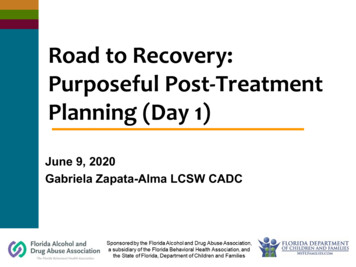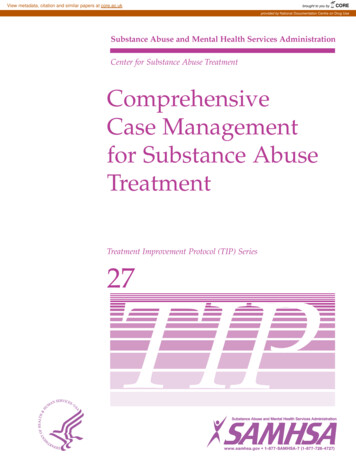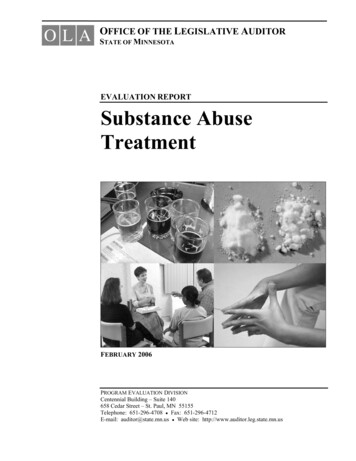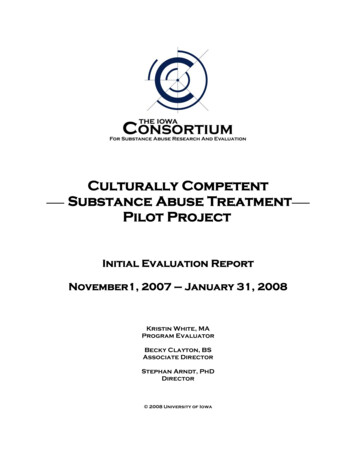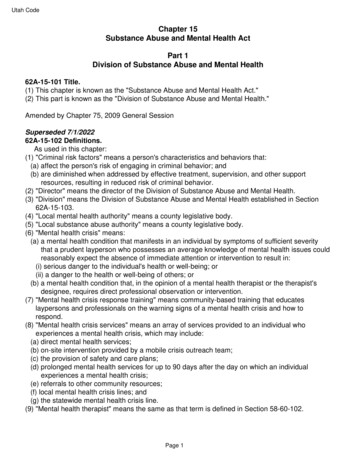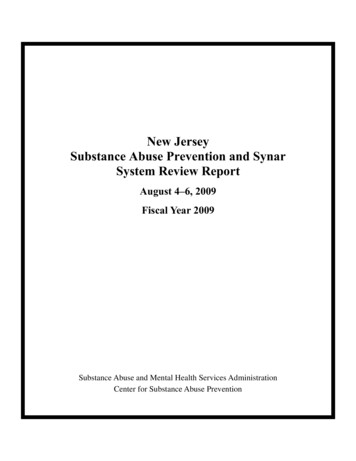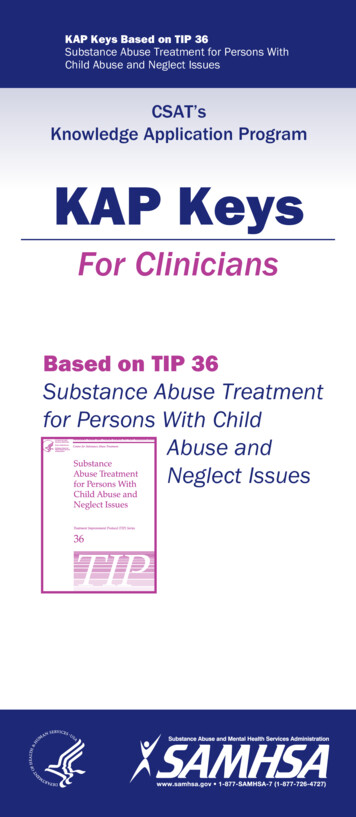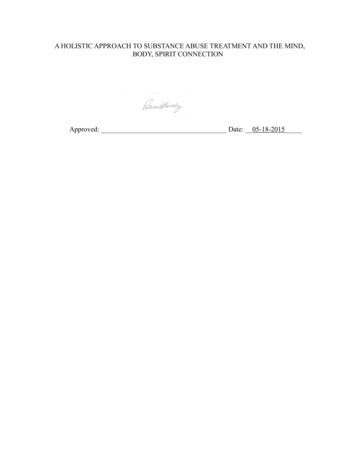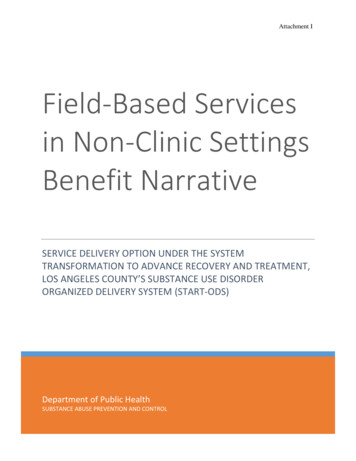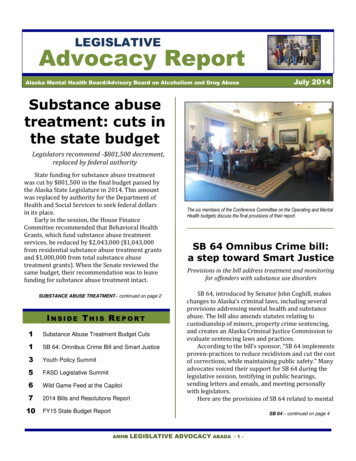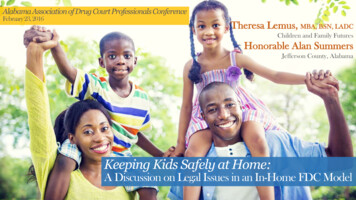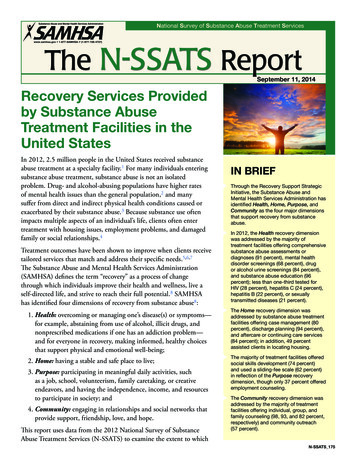
Transcription
National Survey of Substance Abuse Treatment ServicesThe N-SSATS ReportSeptember 11, 2014 ecovery Services ProvidedRby Substance AbuseTreatment Facilities in theUnited StatesIn 2012, 2.5 million people in the United States received substanceabuse treatment at a specialty facility.1 For many individuals enteringsubstance abuse treatment, substance abuse is not an isolatedproblem. Drug- and alcohol-abusing populations have higher ratesof mental health issues than the general population,2 and manysuffer from direct and indirect physical health conditions caused orexacerbated by their substance abuse.3 Because substance use oftenimpacts multiple aspects of an individual’s life, clients often entertreatment with housing issues, employment problems, and damagedfamily or social relationships.4Treatment outcomes have been shown to improve when clients receivetailored services that match and address their specific needs.5,6,7The Substance Abuse and Mental Health Services Administration(SAMHSA) defines the term “recovery” as a process of changethrough which individuals improve their health and wellness, live aself-directed life, and strive to reach their full potential.8 SAMHSAhas identified four dimensions of recovery from substance abuse8:1. Health: overcoming or managing one’s disease(s) or symptoms—for example, abstaining from use of alcohol, illicit drugs, andnonprescribed medications if one has an addiction problem—and for everyone in recovery, making informed, healthy choicesthat support physical and emotional well-being;2. Home: having a stable and safe place to live;3. Purpose: participating in meaningful daily activities, suchas a job, school, volunteerism, family caretaking, or creativeendeavors, and having the independence, income, and resourcesto participate in society; and4. Community: engaging in relationships and social networks thatprovide support, friendship, love, and hope.This report uses data from the 2012 National Survey of SubstanceAbuse Treatment Services (N-SSATS) to examine the extent to whichIN BRIEFXX Through the Recovery Support StrategicInitiative, the Substance Abuse andMental Health Services Administration hasidentified Health, Home, Purpose, andCommunity as the four major dimensionsthat support recovery from substanceabuse.XX In 2012, the Health recovery dimensionwas addressed by the majority oftreatment facilities offering comprehensivesubstance abuse assessments ordiagnoses (91 percent), mental healthdisorder screenings (68 percent), drugor alcohol urine screenings (84 percent),and substance abuse education (96percent); less than one-third tested forHIV (28 percent), hepatitis C (24 percent),hepatitis B (22 percent), or sexuallytransmitted diseases (21 percent).XX The Home recovery dimension wasaddressed by substance abuse treatmentfacilities offering case management (80percent), discharge planning (94 percent),and aftercare or continuing care services(84 percent); in addition, 49 percentassisted clients in locating housing.XX The majority of treatment facilities offeredsocial skills development (74 percent)and used a sliding-fee scale (62 percent)in reflection of the Purpose recoverydimension, though only 37 percent offeredemployment counseling.XX The Community recovery dimension wasaddressed by the majority of treatmentfacilities offering individual, group, andfamily counseling (98, 93, and 82 percent,respectively) and community outreach(57 percent).N-SSATS 175
THE N-SSATS REPORT: Recovery Services Provided bySubstance Abuse Treatment Facilities in the United StatesAssessment and Pre-Treatment ServicesThe most common assessment and pre-treatment servicesprovided by facilities were screening for substanceabuse (95 percent) and comprehensive substance abuseassessment or diagnosis (91 percent) (Figure 1). Amajority of facilities also provided screening for mentalhealth disorders (68 percent). Over half of facilitiesprovided screening for tobacco use (56 percent). Lessthan half of facilities provided comprehensive mentalhealth assessment or diagnosis (47 percent) or interimservices for clients when immediate admission was notpossible (45 percent).substance abuse treatment facilities were providingrecovery support services across each of the fourdimensions of recovery. N-SSATS is an annual, nationalsurvey of all known substance abuse treatment facilities,both public and private, that collects data on a widerange of services commonly offered by facilities. Thisreport includes the data reported by 14,311 substanceabuse treatment facilities.Recovery Dimension 1: HealthBecause recovery pathways reflect the distinct needsand goals of individual treatment clients,5 the Healthdimension of recovery encompasses a wide range ofservices. As the largest category, Health-related servicesinclude assessment and pre-treatment services, testingservices, use of pharmacotherapies, and supportiveancillary services.Testing ServicesThe majority of facilities offered drug or alcohol urinescreening (84 percent) or breathalyzer or other bloodalcohol testing (61 percent) (Figure 2). CommunicableFigure 1. Substance abuse treatment facilities offeringassessment and pre-treatment services in support ofthe Health recovery dimension: 2012Screening forsubstance abuseFigure 2. Substance abuse treatment facilities offeringtesting services in support of the Health recoverydimension: 2012Drug/alcoholurine screening95Comprehensivesubstance abuseassessment or diagnosisSeptember 11, 201484Breathalyzer/otherblood alcohol testing9161TB screeningScreening formental health disorders3668HIV testingScreening fortobacco use2856Screening for hepatitis CComprehensivemental healthassessment or diagnosis47Interim services45025507524Screening for hepatitis B22Sexually transmitteddisease testing210100255075Percent of facilitiesPercent of facilitiesSource: 2012 SAMHSA National Survey of Substance Abuse TreatmentServices (N-SSATS).Source: 2012 SAMHSA National Survey of Substance Abuse TreatmentServices (N-SSATS).2100
THE N-SSATS REPORT: Recovery Services Provided bySubstance Abuse Treatment Facilities in the United Statesmedications, such as buprenorphine with naloxone(Suboxone ; 20 percent), buprenorphine withoutnaloxone (11 percent), or methadone (11 percent),which treat addiction to opioids such as heroin orprescription pain relievers like oxycodone.9disease testing was provided by substantially smallerproportions of facilities. Specifically, 36 percentof facilities provided tuberculosis (TB) screening,28 percent provided testing for HIV, 24 percentscreened for hepatitis C, 22 percent screened forhepatitis B, and 21 percent tested for sexuallytransmitted diseases.Ancillary ServicesThe vast majority of facilities (96 percent) offeredsubstance abuse education (Figure 3). Over half offacilities provided mental health services (62 percent);HIV or AIDS education, counseling, or supportservices (58 percent); and health education otherthan HIV/AIDS or hepatitis (53 percent). About 2in 5 facilities offered smoking cessation counseling(39 percent), and over 1 in 4 facilities (27 percent)provided early intervention for HIV.Pharmacotherapy ServicesMedications for the treatment of psychiatric disorderswere the most commonly provided pharmacotherapy(38 percent) (Table 1). About one-fifth of facilitiesprovided nicotine replacement pharmacotherapy(22 percent) and 16 percent provided non-nicotinetobacco cessation medications. Less than 1 in 5 facilitiesoffered pharmacotherapies used for alcohol and othersubstance abuse treatment, including oral naltrexone(18 percent), Antabuse (17 percent), Campral (17 percent), and Vivitrol (injectable naltrexone;10 percent). One in five or fewer facilities offeredRecovery Dimension 2: HomeThe second dimension of recovery is having a stableand safe place to live. Home-related services provided inTable 1. Substance abuse treatment facilities offeringpharmacotherapies in support of the Health recoverydimension: 2012PharmacotherapiesPercentMedications for psychiatric disorders38Nicotine replacement22Buprenorphine with naloxone(Suboxone )20Naltrexone (oral)18Campral 17Antabuse 17Non-nicotine smoking/tobaccocessation medications16Buprenorphine without naloxone11Methadone11Vivitrol (injectable naltrexone)10September 11, 2014Figure 3. Substance abuse treatment facilities offeringancillary services in support of the Health recoverydimension: 2012Substance abuseeducation9662Mental health servicesHIV or AIDS education,counseling, or support58Health education otherthan HIV/AIDS or hepatitis53Hepatitis education,counseling, or support46Smoking cessationcounseling3927Early intervention for HIVSource: 2012 SAMHSA National Survey of Substance Abuse Treatment Services(N-SSATS).4Acupuncture0255075Percent of facilitiesSource: 2012 SAMHSA National Survey of Substance Abuse TreatmentServices (N-SSATS).3100
THE N-SSATS REPORT: Recovery Services Provided bySubstance Abuse Treatment Facilities in the United States2012 primarily included supportive ancillary servicesas well as services that helped clients transition out oftreatment.September 11, 2014discharge was part of the standard operating proceduresacross 69 percent of facilities.Recovery Dimension 3: PurposeAncillary ServicesFour in five facilities offered case management services(80 percent), and over half offered assistance withobtaining social services, such as Medicaid; Women,Infants, and Children; Supplemental Security Income;and Social Security Disability Income (57 percent)(Table 2). Nearly half of facilities (49 percent) providedassistance in locating housing for substance abusetreatment clients. Similar proportions of facilities offeredtransportation assistance to treatment (41 percent) anddomestic violence services (40 percent).Participating in society through meaningful dailyactivities such as a job, school, or family caretaking iscentral to the Purpose dimension of recovery. Purposerelated services offered by facilities primarily includedancillary services. Since having the resources toparticipate in meaningful activities is also part of thePurpose dimension, services that assisted clients withpaying for their treatment are also included.Transitional and Follow-up ServicesThe majority of facilities offered discharge planning(94 percent) and aftercare or continuing care services(84 percent). Moreover, outcome follow-up afterAncillary ServicesIn 2012, nearly three-quarters (74 percent) offacilities provided services in support of social skillsdevelopment. Employment counseling or training forclients was offered by 37 percent of facilities (data notshown). Only 7 percent provided child care services(data not shown).Table 2. Substance abuse treatment facilities offeringancillary, transitional, and follow-up services insupport of the Home recovery dimension: 2012Figure 4. Types of payment accepted at substanceabuse treatment facilities in support of the Purposerecovery dimension: 2012ServicePercentSelf-paymentAncillary services90Case management services80Private health insuranceAssistance with obtainingsocial services57Assistance in locating housingfor clientsMedicaid/federalmilitary insurance49Transportation assistance totreatment41Federal military insurance33Domestic violence—family orpartner violence services40Medicare33Discharge planning94Access to Recovery (ATR)vouchersIHS/638 contract carefundsAftercare/continuing care84Outcome follow-up after discharge696558State-financed insuranceTransitional and follow-upservices40135No payment accepted3OtherSource: 2012 SAMHSA National Survey of Substance Abuse Treatment Services(N-SSATS).50255075Percent of facilitiesSource: 2012 SAMHSA National Survey of Substance Abuse TreatmentServices (N-SSATS).4100
THE N-SSATS REPORT: Recovery Services Provided bySubstance Abuse Treatment Facilities in the United StatesPayment ServicesOver half of facilities (62 percent) used a sliding-feescale to determine an appropriate charge for servicesbased on their clients’ economic situations (data notshown); 9 in 10 facilities (90 percent) accepted selfpayment for substance abuse treatment (Figure 4).Nearly two-thirds (65 percent) of facilities acceptedprivate health insurance, and over half (58 percent)accepted Medicaid. A third of facilities (33 percent)accepted Medicare or federal military insurance suchas TRICARE or CHAMPVA.Recovery Dimension 4: CommunityThe role of Community in recovery refers torelationships and social networks that provide support,friendship, love, and hope. One way that treatmentprograms facilitate therapeutic networking, fosterhealthy relationships, and provide targeted services isto offer specially designed substance abuse treatmentprograms or groups for specified types of clients.In addition, Community-related services also includedcounseling, ancillary, and pre-treatment services.Figure 5. Substance abuse treatment facilities offeringspecially designed programs or groups in support ofthe Community recovery dimension: 2012Clients withco-occurring disorders37Adult womenSpecially Designed Programs or GroupsOver a third (37 percent) of facilities offered a speciallydesigned program or group for clients with co-occurringmental and substance abuse disorders (Figure 5). Overa quarter of facilities offered a special program or31Adolescents28Adult menSeptember 11, 201425Criminal justice clients(non-DUI/DWI)Figure 6. Substance abuse treatment facilitiesoffering specific types of counseling in support of theCommunity recovery dimension: 201223Persons who haveexperienced trauma2210012Pregnant or postpartum9893828Seniors or older adults7Veterans7Lesbian, gay, bisexual,transgender, or questioning75Percent of facilitiesPersons with HIV/AIDS6Members ofmilitary families4Active duty military459502514Other0102030400IndividualPercent of facilitiesSource: 2012 SAMHSA National Survey of Substance Abuse TreatmentServices (N-SSATS).GroupFamilyMaritalSource: 2012 SAMHSA National Survey of Substance Abuse TreatmentServices (N-SSATS).5
THE N-SSATS REPORT: Recovery Services Provided bySubstance Abuse Treatment Facilities in the United Statesgroup for adult women (31 percent) or for adolescents(28 percent), and a quarter of facilities (25 percent)offered a special program or group for adult men.Nearly a quarter of facilities (23 percent) offered aspecially designed program or group for criminal justiceclients (other than DUI/DWI). Twelve percent offacilities offered a specially designed program or groupfor pregnant or postpartum women. Less than 1 in10 facilities offered a specially designed program orgroup for persons with HIV or AIDS (8 percent); forveterans and seniors or older adults (both 7 percent); forlesbian, gay, bisexual, transgender, or questioning clients(6 percent); and for members of military families oractive duty military (4 percent each).September 11, 2014However, communicable disease testing, comprehensivemental health assessments or diagnoses, and theprovision of mental disorder medications were lesscommonly offered. These may be areas in need ofincreased resources given the high rates of these problemsin substance abuse treatment populations and researchshowing improved treatment outcomes when the neededmedical and mental health services are received.5,6,10Several notable findings support the Home and Purposerecovery dimensions. Specifically, about half of facilitiesoffered clients assistance with obtaining social servicesand locating housing, and most facilities providedtransitional services such as discharge planning andaftercare or continuing care services. These servicesare critical as the provision of housing assistance andservices that address aftercare needs have been shownto improve treatment outcomes.11,12,13 Because servicesthat address access barriers have been associated withreductions in post treatment substance use,13 it isnotable that most facilities used a sliding-fee scaleand accepted Medicaid. However, less than twofifths of facilities offered employment counseling;given that employment has been shown to be animportant component of treatment success and posttreatment recovery, this may be one area that treatmentadministrators may consider expanding.11,12 Finally, theCommunity recovery dimension was primarily addressedthrough counseling, community outreach efforts, andmentoring or peer support.Counseling ServicesCounseling services can help clients in treatmentwith their addiction, as well as address interpersonalproblems they are having with spouses, children,friends, and others in their social network. Virtually allfacilities provided individual counseling (98 percent),and the majority provided group counseling or familycounseling (93 and 82 percent, respectively) (Figure 6).Marital/couples counseling was provided by over half(59 percent) of all facilities.Other ServicesIn 2012, over half of facilities provided outreach topersons in the community who may have neededtreatment (57 percent; data not shown). Mentoring orpeer support was provided by over half (52 percent) offacilities. Self-help groups (e.g., Alcoholics Anonymous,Narcotics Anonymous, and SMART Recovery) wereoffered by nearly half (47 percent) of facilities (data notshown).Because individuals in treatment often face substantialchallenges in addition to their substance abuse, it isimportant that facilities are equipped to address all fourof the recovery dimensions to support enduring positiveoutcomes for their clients. Additional information onsubstance abuse recovery is available at the SAMHSA’sRecovery Support Web site (http://www.samhsa.gov/recovery/). Individuals in need of substance abusetreatment can use SAMHSA’s Behavioral HealthTreatment Services Locator, which may be accessedat http://findtreatment.samhsa.gov/. Users can searchthe Locator for facilities by location and by specificcharacteristics, such as the types of services offeredincluding payment assistance options, special programs/groups offered, and type of care.DiscussionFindings from this report indicate that the nation’ssubstance abuse treatment facilities offered a rangeof services that reflect SAMHSA’s four key recoverydimensions: Health, Home, Purpose, and Community.The Health recovery dimension was addressed primarilythrough substance abuse screening and comprehensivesubstance abuse assessment or diagnosis, substanceabuse education, and drug or alcohol urine screening.6
THE N-SSATS REPORT: Recovery Services Provided bySubstance Abuse Treatment Facilities in the United StatesEnd NotesSeptember 11, 2014may be dispensed only in opioid treatment programs (OTPs), whichare certified by the Substance Abuse and Mental Health ServicesAdministration (SAMHSA). Treatment protocols require that aclient take the medication at the clinic where it is dispensed daily;take-home dosages are allowed only for clients who have beenin treatment for an extended period of time and meet additionalrequirements. Conversely, buprenorphine may be prescribed byphysicians who obtain specialized training. Thus, it is possible forbuprenorphine-trained physicians to operate out of private practicesand through substance abuse treatment facilities or programs. Thebuprenorphine services indicated in this report include only thosewho operate in conjunction with a substance abuse treatment facility;it does not include the private practice physicians.1. Center for Behavioral Health Statistics and Quality. (2013). Resultsfrom the 2012 National Survey on Drug Use and Health: Summary ofnational findings (HHS Publication No. SMA 13–4795, NSDUH SeriesH–46). Rockville, MD: Substance Abuse and Mental Health ServicesAdministration.2. Center for Behavioral Health Statistics and Quality. (2013). Resultsfrom the 2012 National Survey on Drug Use and Health: Mentalhealth findings (HHS Publication No. SMA 13–4805, NSDUH SeriesH–47). Rockville, MD: Substance Abuse and Mental Health ServicesAdministration.3. Sullivan, L. E., & O’Connor, P. G. (2004). Medical disorders insubstance abuse patients. In H. R. Kranzler & J. A. Tinsley (Eds.),Dual diagnosis and psychiatric treatment: Substance abuse andcomorbid disorders (2nd ed., pp. 425–457). New York, NY: MarcelDekker, Inc.Although 11 percent of substance abuse treatment facilities offeredmethadone, only 8 percent of facilities were classified as OTPs. Thereason for the difference is that some facilities, such as hospitals,can prescribe methadone for purposes other than treatment of opioidaddiction, such as for pain relief, or can use methadone in emergencysituations without being a SAMHSA-certified OTP.4. Substance Abuse and Mental Health Services Administration. (2012).Comprehensive case management for substance abuse treatment.(HHS Publication No. SMA 12–4215, Treatment ImprovementProtocol [TIP] Series No. 27). Rockville, MD: Author.10. Grella, C. E., & Stein, J. A. (2006). Impact of program services ontreatment outcomes of patients with comorbid mental and substanceuse disorders. Psychiatric Services, 57(7), 1007–1015.5. Friedmann, P. D., Hendrickson, J. C., Gerstein, D. R., & Zhang, Z.(2004). The effect of matching comprehensive services to patients’needs on drug use improvement in addiction treatment. Addiction,99(8), 962–972.11. Marsh, J. C., Cao, D., & D’Aunno, T. (2004). Gender differences inthe impact of comprehensive services in substance abuse treatment.Journal of Substance Abuse Treatment, 27(4), 289–300.12. McLellan, A. T., Hagan, T. A., Levine, M., Gould, F., Meyers, K.,Bencivengo, M., & Durell, J. (1998). Supplemental social servicesimprove outcomes in public addiction treatment. Addiction,93(10),1489–1499.6. Institute of Medicine, Committee on Crossing the Quality Chasm:Adaptation to Mental Health and Addictive Disorders. (2006).Improving the quality of health care for mental and substanceuse conditions: Quality chasm series. Washington, DC: NationalAcademies Press.13. Krupski, A., Campbell, K., Joesch, J. M., Lucenko, B. A., & RoyByrne, P. (2009). Impact of Access to Recovery (ATR) services onalcohol/drug treatment outcomes. Journal of Substance AbuseTreatment, 37(4), 435–442.7. National Institute on Drug Abuse. (2012). Principles of drug addictiontreatment: A research-based guide (3rd ed.; NIH Publication No.12–4180). Bethesda, MD: Author.8. Substance Abuse and Mental Health Services Administration. (2012).SAMHSA’s Working definition of recovery. Retrieved from PEP12-RECDEF.pdfSuggested CitationSubstance Abuse and Mental Health Services Administration, Centerfor Behavioral Health Statistics and Quality. (September 11, 2014). TheN-SSATS Report: Recovery Services Provided by Substance AbuseTreatment Facilities in the United States. Rockville, MD.9. Two opioid medications are approved for the effective treatmentof opioid addiction: methadone and buprenorphine. MethadoneThe Substance Abuse and Mental Health Services Administration (SAMHSA) isthe agency within the U.S. Department of Health and Human Services that leadspublic health efforts to advance the behavioral health of the nation. SAMHSA’smission is to reduce the impact of substance abuse and mental illness onAmerica’s communities.(2) client count information such as counts of clients served by service type andnumber of beds designated for treatment; and (3) general information such aslicensure, certification, or accreditation and facility Web site availability. In 2012,N-SSATS collected information from 14,311 facilities from all 50 states, theDistrict of Columbia, Puerto Rico, the Federated States of Micronesia, Guam,Palau, and the Virgin Islands. Information and data for this report are basedon data reported to N-SSATS for the survey reference date March 30, 2012.The National Survey of Substance Abuse Treatment Services (N-SSATS) is anannual survey designed to collect information from all facilities in the UnitedStates, both public and private, that provide substance abuse treatment.N-SSATS provides the mechanism for quantifying the dynamic character andcomposition of the U.S. substance abuse treatment delivery system. Theobjectives of N-SSATS are to collect multipurpose data that can be used toassist SAMHSA and state and local governments in assessing the nature andextent of services provided and in forecasting treatment resource requirements,to update SAMHSA’s Inventory of Behavioral Health Services (I-BHS), to analyzegeneral treatment services trends, and to generate the Behavioral HealthTreatment Services Locator (http://findtreatment.samhsa.gov/).The N-SSATS Report is prepared by the Center for Behavioral Health Statisticsand Quality, SAMHSA; Synectics for Management Decisions, Inc., Arlington, VA;and RTI International, Research Triangle Park, NC.Latest N-SSATS ATSLatest N-SSATS public use files and variable definitions:http://datafiles.samhsa.govOther substance abuse reports:http://www.samhsa.gov/dataN-SSATS is one component of the Behavioral Health Services InformationSystem (BHSIS), maintained by the Center for Behavioral Health Statistics andQuality (CBHSQ), SAMHSA. N-SSATS collects three types of information fromfacilities: (1) characteristics of individual facilities such as services offered andtypes of treatment provided, primary focus of the facility, and payment options;U.S. DEPARTMENT OF HEALTH & HUMAN SERVICESSubstance Abuse & Mental Health Services AdministrationCenter for Behavioral Health Statistics and Qualitywww.samhsa.gov/data7
In 2012, 2.5 million people in the United States received substance abuse treatment at a specialty facility.1 For many individuals entering substance abuse treatment, substance abuse is not an isolated problem. Drug- and alcohol-abusing populations have higher rates of mental health issues than the general population,2 and many
